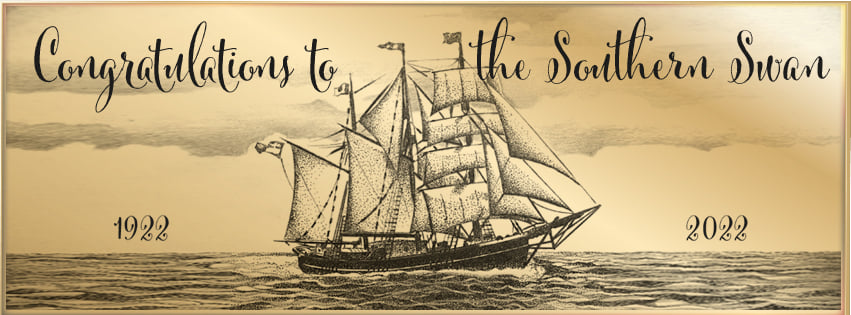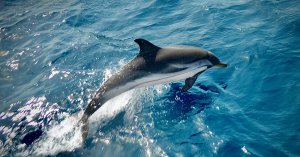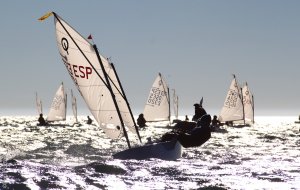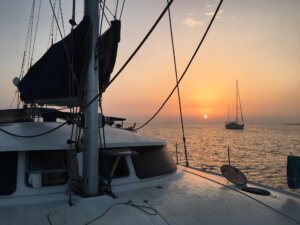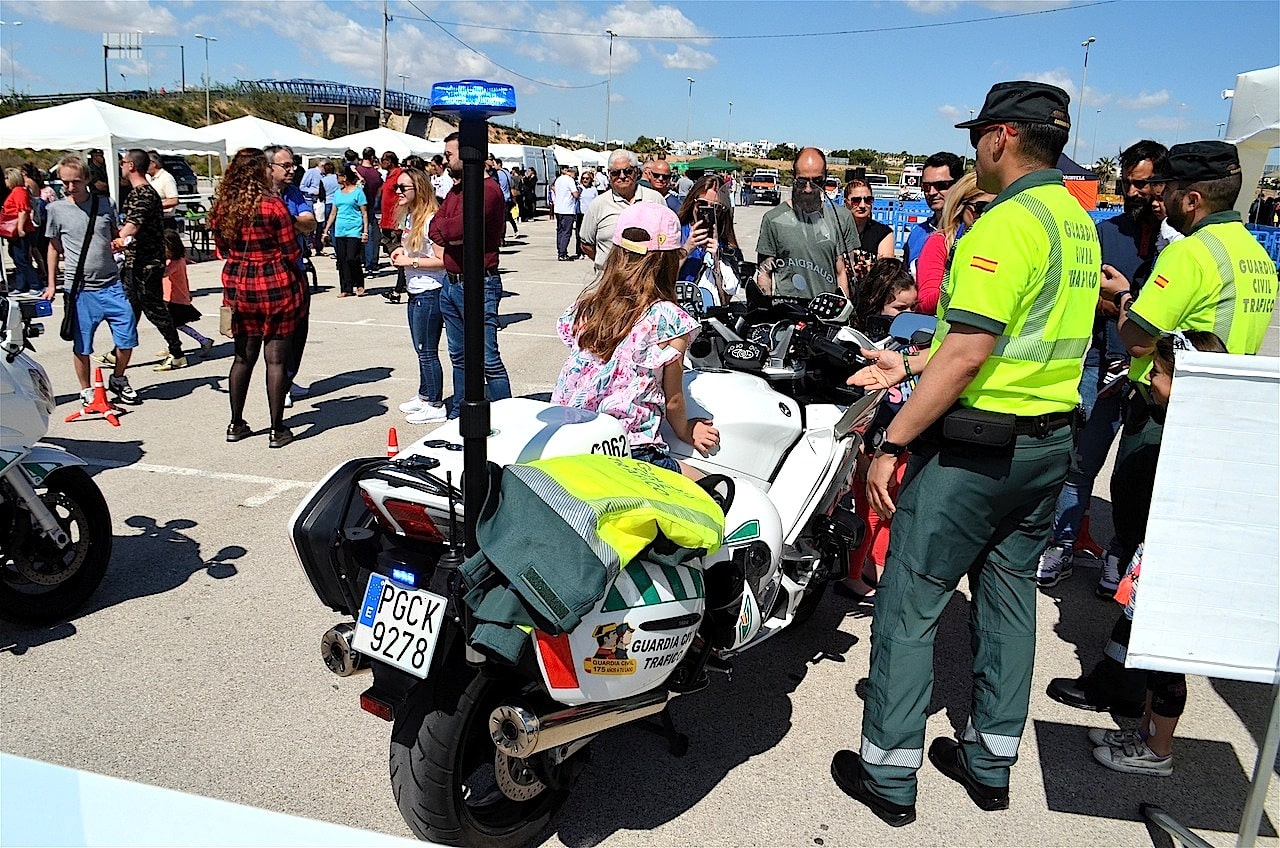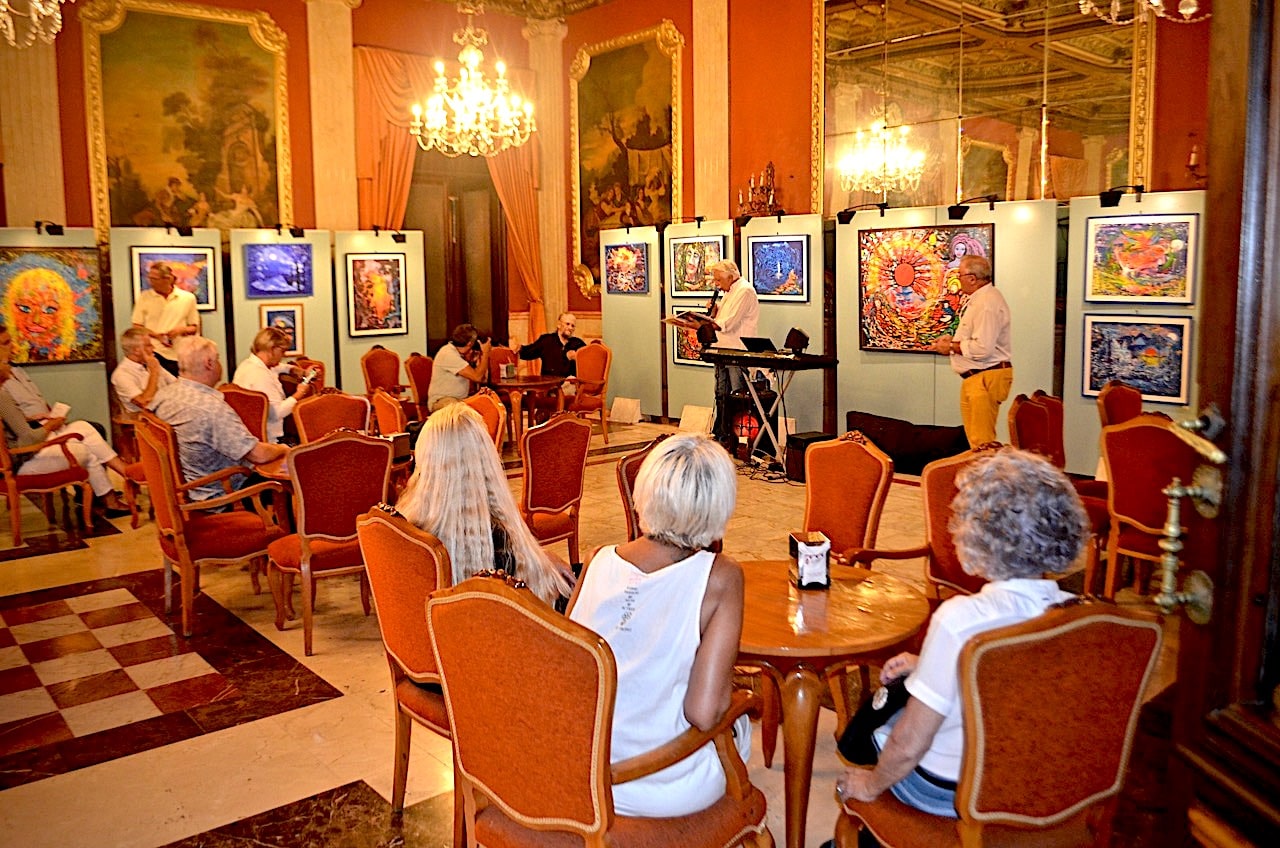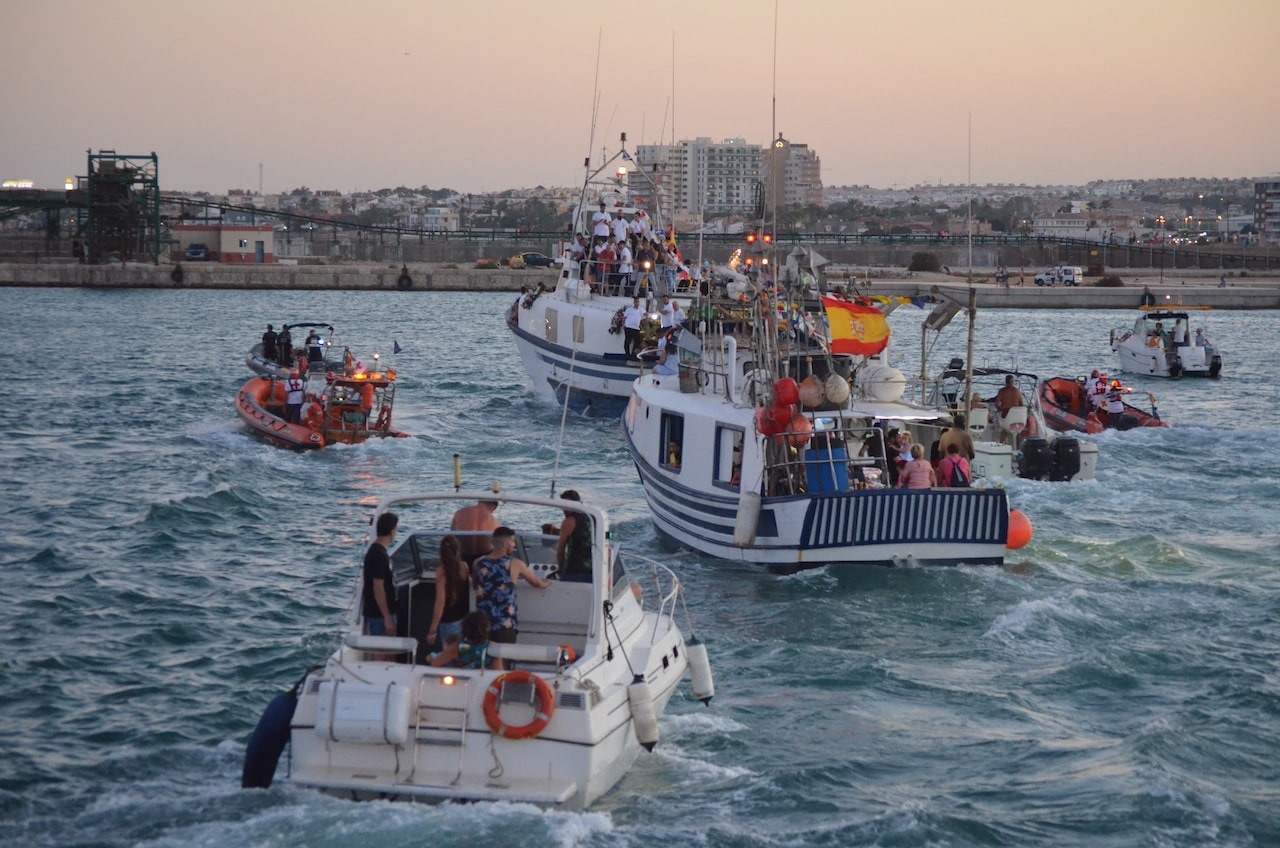On board a windjammer 3,500 nautical miles through the southern Atlantic Ocean
“The task is life, but the adventure is the poetry.” (Ernst Jünger)
Wind force eleven on the southern Atlantic, midnight watch aboard the tall ship “Our Svanen”. Around the railing of the windjammer, the whitecaps of roaring breakwaters tower to dizzying heights. The sea, which had been so peaceful just a few hours before, seethes beside us as it gurgles white. Dark masses of water beat over the ship’s side and thunder downwind over the scuppers. The hurricane howls in the rigging, whistles through the shrouds and stage, and drives swaths of spray horizontally across the deck. The windjammer works its way through the waves with a heavy pounding.
It is pitch black night. Only the compass light at the helm casts a faint reddish glow over the quarterdeck. High above my head, sails rattle wildly in the storm wind. Two weeks of fair-weather sailing from Rio de Janeiro heading for Cape Town have come to an abrupt end here, 45 degrees latitude below the equator.
“Take that bastard down!” roars Bruce, Australian and first mate of the Our Svanen, from the helm against the storm. Reluctantly, John and I climb into the rigging to lash the wet canvas to the yard. Dizzy fifteen feet above the deck planks and storm-lashed seas, eyes watering from the wind, my clammy fingers feel for one handhold after another. Our hands, calloused and torn, have long since lost all feeling for the rough hemp ropes of the sail lines.
In a “hair jerk,” we pull up the wet sailcloth, roll up the coarse line, and lash it tight. “Goddam’!” resounds up from below, “Hurry up!” We work doggedly. Sweat and spray burn my eyes. The cold south wind whips rainwater into the collar of the sodden oilskin.
Fear? Yes! A moment of carelessness, a missed grip … and the wildly swinging masts inevitably hurl the unwary into the boiling sea. Below me, the waves with their white crests of foam already seem to be baring their teeth.
The experience of the violence of the breakers washing in during the storm ended my romantic love of seafaring in the blink of an eye. And yet: at the edge of our existence, in the pleasure of danger, every moment of life intensifies! Once you have tasted the exhilaration of crossing the vastness of the ocean off the beaten track, you will never again let go of the fascination of adventure and freedom under sail.
Exhausted after the hard night’s watch, I lean against the railing. Sailing like Columbus, like Magellan, like Drake, those modern brothers of the legendary Ulysses: despite satellite navigation, refrigerated cabinets and auxiliary engines, windjammers have lost none of their original promise.
Flashback. The zero hour of our ocean crossing. Location: The marina in Rio de Janeiro. On board the Our Svanen, there is a feverish bustle. The voice of Jay, the captain, rolls over. “To the braces! Fies on the mainsheet! Make ready the mainsail!” Choppy, the command voice echoes across the foredeck in Canadian slang. In the tropical Brazilian heat, sweat runs down the bare torsos of the nine-man crew. We climb into the rigging, untie sail line after sail line, and then 900 square meters of white sailcloth billow up into Brazil’s cobalt blue sky.
With a fresh breeze, the windjammer picks up speed, sailing through the Bay of Guanabara, past Sugarloaf Mountain, the beaches of Ipanema and Copacabana, and the skyline of the tropical metropolis of Rio de Janeiro. From the top of the mast, I take one last look back at the blue-gray mountain backdrop of the Brazilian coast, at the continent blurring on the horizon. Bye bye, Brazil!
In front of the bow of the windjammer now pounding heavily through the waves, 3,500 nautical miles stretch across the stormy Atlantic – a four-week sailing trip from South America to South Africa. We can expect long wet and cold night watches on deck and strict discipline on board. We are in a boat – literally. It’s a queasy feeling to trust, for better or worse, the seaworthiness of a ship and the ability of the crew. “In the event of misfortune,” it says in black and white in my contract as a light seaman, “the undersigned waives all claims. In the event of death, to be notified…”
“It’s a long way across the ocean!” – these words of the captain were to come to my mind many times. For the next four weeks, the Our Svanen was home, world and, if need be, also a charnel box for nine immortal human souls. The tall ship, launched in 1922, cruised off the Scandinavian coast as a grain schooner until 1960, when it served as a training ship for Canadian naval cadets. Today, the Our Svanen is one of about a hundred windjammers still sailing the seven seas. The great age of sailing has been passé for two generations.
For the Atlantic crossing, an international crew had come together on board our swaying home. Jay is from Vancouver, the home port of the Our Svanen. He joined the ship when he was 15 – as a sea cadet. John, three-day beard, black curly hair and ice-blue eyes, had studied literature at Oxford before signing on as a sailor on tall ships. Jim, ship’s cook and thus the most important man on board after the captain, was a born bon vivant. Bruce, first mate, sailed ocean racing yachts off Australia before switching to “more classical sailing” on old windjammers. Clinton hails from sunny Jamaica. “Hang loose, man,” was his favorite saying even in heavy weather on the southern Atlantic – always hang loose! Two women also had to stand their ground on board. Glenn’s and Nerida’s hands looked as battered as the rest of the crew’s after a few days at sea.
During the first days at sea, Neptune was kind to us. A constant fresh breeze pushed the Our Svanen southeast towards Africa. The days at sea flowed by in a stubborn rhythm of changing watches. Sails need to be sewn, the old coat of varnish needs to be stripped from the deckhouse, and the mizzen mast also needs a new coat of paint. The repair and overhaul work wants to be completed while we still have good weather in tropical latitudes.
Everyday work on board. Glenn and Nerida sit on the aft deck and sew leather reinforcements into the worn sail leeches. I’m dangling ten meters up in a canvas cradle on the mizzen mast, a paintbrush in my hand, the paint pot tied in front of my chest. Through clenched teeth, I struggle to compensate for the mast’s treacherous pendulum movements. But in vain. Suddenly, the masthead swings wide and the clear coat flings in a wide arc over my shirt and pants. “Damn!” I hear myself swear at the top of my voice. “Goddam!” it echoes up from below. Glenn had bent another sewing needle in the tough leather.
Change of watch aboard the Our Svanen. Midnight. Squeaking, the deck hatch is yanked open. “Wake up, man!” someone yells down. The sea gurgles deeply behind the heavy wooden planks next to my bunk. Shivering, I shuffle into my rubber boots, which have been wet for days, my clammy sweater, and my shapeless oilskin. On deck, it’s magically bright. Gusty southwest winds howl in the rigging, the rigging groans and creaks. The moon bathes the sailor in silvery matt light. Billions of stars sparkle above us in the southern sky.
The bow crashes again and again into the darkly threatening oily sea. The water foams white and rises on both sides of the bowsprit; for fractions of a second, a glittering phosphorescent carpet lies on the mighty black wave crests. At seven knots, the old lady makes proud speed ahead.
All hands are on deck. In the chart room I hear the bad news. A man has gone overboard on a ship sailing miles abeam, and he has not returned from the sail. “Pan relay, man over board on Anna Kristina,” reads the last entry in the radio log, “position 31’21 South, 15’50 West.” Again the radio blares and crackles, “No sign of man over board, two life rings in water.”
Jay and Bruce decide to change course. There is still a glimmer of hope of picking up the drowning man. In our wake, we motor to the indicated accident site. We stand on the deckhouse with searchlights, strong fingers of light scanning the dark gray crests of the waves. Hour after hour passes agonizingly slowly. At dawn, we take turns with binoculars.
After 36 hours, Jay calls off the search: No one survives longer than a few hours in water that is 15 degrees Celsius cold. At the changing of the guard, we meet on the quarterdeck for a moment of silence. Jay reads Psalm 90 from the fourth book: “Our life is seventy years, and when it comes to the end, it is eighty years, and what seems to be good in it is only vain toil, for it passes quickly as if we were flying away. Teach us to remember that we must die, that we may become wise…”
Two hard days lie behind us. During the simple ceremony according to sailor custom, hardly anyone looks the other in the eye. We all know that the same fate can befall us at any time.
At sunrise, the wind dies down for the first time in days, the waves subside, and every now and then a little blue sky shimmers through between the gray cloud banks. The rising sun shines thousands of glittering reflections of light on the ice-gray sea, which looks as if it has been cast in lead. After three weeks at sea, Jim rations our fresh fruit. John has already run out of cigarettes halfway across. My chocolate is also down to one bar per watch.
“All clear to re-embark!” While we scrub the planks, Jim rattles pots and pans in the galley. Soon the smell of pancakes and hot chocolate is delicious. “Breakfast ready!” How I have come to appreciate those redeeming words after long cold nights under the Southern Cross!
On the morning of the 35th day, after 102 hard watches at sea, the Our Svanen sails into Cape Town Bay accompanied by dozens of motorboats and sailing dinghies. At the Cape of Good Hope, the anchor rattles into the deep. “Hey,” Jay calls to me, beaming with joy from the harbor quay, “we made it, welcome in Africa!”
The Ship
Originally named Our Svanen, the Southern Swan is a magnificent three-masted barquentine built in Denmark in 1922. Made of Danish oak she is a unique vessel, whilst not classified as an icebreaker, her hull is extraordinarily strong enabling her to handle light ice that may have built up in the cold waters of the North Atlantic, Denmark and Greenland, where she originally traded as a grain carrier.
The Southern Swan has a unique nautical history. Originally configured as a gaff schooner, she sailed Baltic trade routes as a cargo vessel for the Tuborg brewery for many years until 1969. In 1969 she was purchased as a private vessel and extensively refitted to handle larger and longer ocean voyages. She served as a sail training vessel with the Canadian Sea Cadets and journeyed to Vancouver to appear at the World Expo in 1986. She then sailed to England to join the First Fleet Re-enactment.
The Southern Swan made the voyage from England to Australia in 1988 to take part in the famous Australian Bicentennial First Fleet Re-enactment.
Read more:

